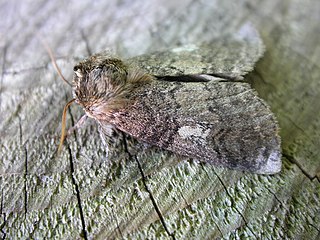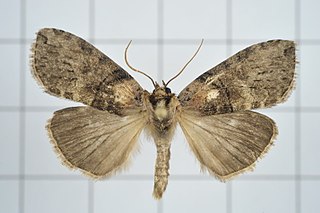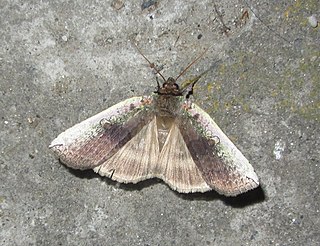
Tethea ocularis, the figure of eighty, is a moth of the family Drepanidae. The species was first described by Carl Linnaeus in his 1767 12th edition of Systema Naturae. It is found throughout Continental Europe and has a scattered distribution in England and Wales, although it is absent from Scotland and Ireland.

The Thyatirinae, or false owlet moths, are a subfamily of the moth family Drepanidae with about 200 species described. Until recently, most classifications treated this group as a separate family called Thyatiridae.

Tethea or, the poplar lutestring, is a moth of the family Drepanidae. It was first described by Michael Denis and Ignaz Schiffermüller in 1775. The species can be found in Europe, northern and eastern Asia and Japan. The imago resembles Tethea ocularis.

Drillia albicostata is a species of sea snail, a marine gastropod mollusk in the family Drilliidae.

Tethea is a genus of moths belonging to the family Drepanidae and subfamily Thyatirinae. It was first described by Ferdinand Ochsenheimer in 1816.

Tethea consimilis is a species of moth of the family Drepanidae first described by Warren in 1912. It is found in Asia, including the Russian Far East, Japan, Korea, Taiwan, Myanmar, Indonesia and India. The habitat consists of various types of mixed and broad-leaved forests.
Scoliacma albicostata is a moth in the family Erebidae. It was described by George Hampson in 1918. It is found in Papua New Guinea.

Horipsestis aenea is a moth in the family Drepanidae. It was described by Wileman in 1911. It is found in Taiwan, the Chinese provinces of Henan, Shaanxi, Gansu, Hubei, Jiangxi, Hunan, Fujian, Guangxi, Hainan, Sichuan and Yunnan and in Vietnam.
Tethea albicosta is a moth in the family Drepanidae. It is found in Nepal, Assam in India, Myanmar and the Chinese provinces of Hubei, Hunan, Sichuan, Guangdong, Guangxi, Yunnan and Tibet.

Tethea oberthueri is a moth in the family Drepanidae. It is found in Burma, Nepal, Malaysia, India, China, Taiwan and also on Borneo.
Tethea ampliata is a moth in the family Drepanidae. It is found in the Russian Far East, Korea, Japan, Taiwan and northern and north-eastern China.
Tethea fusca is a moth in the family Drepanidae first described by Werny in 1966. It is found in the Chinese provinces of Sichuan and Yunnan.

Tethea octogesima is a moth in the family Drepanidae first described by Arthur Gardiner Butler in 1878. It is found in Japan, Korea, China, Taiwan and the Russian Far East.
Tethea punctorenalia is a moth in the family Drepanidae. It is found in the Chinese provinces of Shaanxi and Sichuan.
Tethea subampliata is a moth in the family Drepanidae. It is found in the Chinese provinces of Sichuan and Yunnan and in Myanmar.
Tethea trifolium is a moth in the family Drepanidae. It is found in China, the Russian Far East and Japan. The habitat consists of various types of mixed and broad-leaved forests.
Nemacerota pectinata is a moth in the family Drepanidae. It was described by Constant Vincent Houlbert in 1921. It is found in the Chinese provinces of Shaanxi, Sichuan and Yunnan.
Coleotechnites albicostata, the white-edged coleotechnites moth, is a moth of the family Gelechiidae. It is found in North America, where it has been recorded from Alabama, Maryland, Mississippi, New Jersey, North Carolina, Ontario and Tennessee.
Aithorape albicostata is a moth of the family Megalopygidae. It was described by Walter Hopp in 1927. It is found in Trinidad, Brazil and Paraguay.







